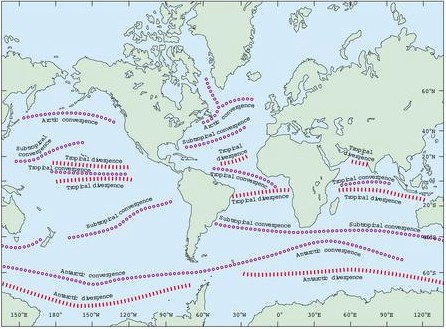zones of convergence/divergence
A BROAD AREA WHERE two tectonic plates are colliding is a zone of convergence. An area where plates are moving apart is a zone of divergence. Convection in Earth's mantle drives the two motions. Convergence occurs above descending limbs of convective cells, whereas divergence takes place above cells' rising limbs. The two zones' geologies are similar in many ways—they both have mountain building, earthquakes, and volcanic eruptions—but their geologies also differ in important ways.
ZONE OF DIVERGENCE
This zone is due to seafloor spreading or continental rifting, which may lead to seafloor development. Spreading occurs as basaltic magma from the mantle rises into vertical tensional fractures in the lithosphere. This zone is constructive, as volcanism adds basalt rock to the lithosphere. Midocean ridges, rift valleys, normal (dip-slip) and strike-slip faulting, and basaltic volcanism characterize the zone of divergence.

Two kinds of undersea mountain ranges—oceanic ridges and rises—make up the largest zones of divergence. The faster the spreading rate is, the broader and lower the mountain range appears. Rises are low midoceanic ridges because their spreading rates are faster. For example, the East Pacific Rise between the Pacific Plate and the Nazca Plate is gently sloping because spreading rates are 6.5 in (16.5 cm) per year. Ridges, on the other hand, stand higher above the seafloor because spreading rates are slow. For instance, the spreading rates of the Mid-Atlantic Ridge are 0.8–1.2 in (2–3 cm) per year. Central rift valleys tend to occupy the axes of the ridges; the only exception is when spreading rates are too fast for valleys to form. The East Pacific Rise lacks a central rift valley for the most part. The eastern Africa rift system is an example of a divergent zone on land. The nearby RED SEA and Gulf of Aden represent more intense spreading than that of the African rift area.
ZONE OF CONVERGENCE
This zone forms the boundary between two tectonic plates that are coming together. Compressional stress in the lithosphere occurs as the plates approach each other. In most instances, this zone is destructive, as the demise of rock by means of subduction usually takes place here. Subduction, oceanic trenches, folding, reverse (dip-slip) faulting, and andesitic (explosive) volcanism characterize the zone of convergence.
There are three types of convergent plate boundary zones. An oceanic plate collides with a continental plate to create an ocean-to-continent boundary. The oceanic plate is made of denser, heavier mafic rock (e.g., basalt), so it subducts, forms an oceanic trench, and melts to form magma beneath the continental plate. The magma rises, melts sialic rock (e.g., granite) of the continental crust, and becomes explosive andesitic magma.
Volcanoes that form along the edge of the continent experience some of the world's most violent eruptions as a result. The collision also creates massive folded mountains on the continent's edge. The Peru–Chile trench and the ANDES MOUNTAINS area betwee the Nazca and the South America plates is an example of an ocean-to-continent boundary zone. The second convergent boundary is the ocean-to-ocean type. Neither of the convergent plates have a continent, but one of the oceanic plates is made of slightly denser rock and therefore subducts. An oceanic trench and a volcanic island arch-trench system develop. The magma tends to be more basaltic than andesite, and volcanic eruptions are therefore usually less explosive.
The western side of the PACIFIC OCEAN has numerous convergent zones of this type; the Mariana Islands and the Mariana trench are a classic example. A third convergent boundary zone forms from a continent-tocontinent collision, that is, the collision of two tectonic plates with continents on them. Suturing is a term that describes this type of convergence. Hardly any subduction takes place at the time of collision, so the zone is generally volcano-free, but intense crustal folding and mountain building take place. The area of the HIMALAYAS in Asia is a classic example of this type of convergent boundary zone.